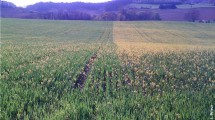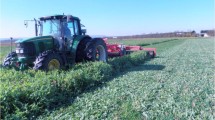Abstract
Can we quantify the impact of invasive species? Here we use the per-plant competitiveness of alien weeds on crops as a model of invasive species impact in general. We reviewed 97 weed–crop competition experiments in 32 papers that included 30 alien weed and 14 crop species. The majority (68.92%) were randomised block designs where the alien weed had been either added (additive experiments) or removed (removal experiments). We propose using the relative competition index to estimate the effect of alien species in all systems, specifying in each case the density and proportion of alien and native plants essayed. We found that the impact of the weed cannot be considered independently of the crop and, thus, we should be cautious in ranking weed species according to their competition effect. A similar situation can be postulated for alien plants interfering with native species. Invaded communities are not random assemblages, and researchers tend to study the most competitive alien plants. We also found that the effect of the weed on crop yield depends on the duration of the interference and the life-history stage of the weed–crop system at which the interaction takes place. We were not able to conduct a more rigorous comparative analysis of the impacts, such as a meta-analysis. To do this would require some measure of the variation of the competition effect such as standard deviation or standard error, which we found are almost never reported.
Similar content being viewed by others
References
Aarsen LW and Epp GA (1990) Neighbour manipulations in the natural vegetation: a review. Journal of Vegetation Science 1: 13-30
Anderson RL (1993) Joined goatgrass (Aegilops cilindrica) ecology and interference in winter wheat. Weed Science 41: 388-393
Arnquist G and Wooster D (1995) Meta-analysis: synthesizing research findings in ecology and evolution. Trends in Ecology and Evolution 10: 236-240
Bell AR and Nalewaja JD (1968a) Competition of wild oat in wheat and barley. Weed Science 16: 505-508
Bell AR and Nalewaja JD (1968b) Competition of wild oat in flax. Weed Science 16: 501-505
Bridgemohan P and McDavid CR (1993) A model of the competitive relationships between R. cochinchinensis and Zea mays. Annals of Applied Biology 123: 649-656
Connolly J (1986) On difficulties with replacement series methodology in mixture experiments. Journal of Applied Ecology 23: 125-127
Connolly J (1988) What is wrong with replacement series? Trends in Ecology and Evolution 3: 24-26
Cousens RD (1985a) A simple model relating yield loss to weed density. Annals of Applied Biology 107: 239-252
Cousens RD (1985b) An empirical model relating crop yield to weed and crop density and a statistical comparison with other models. Journal of Agriculture Science 105: 513-521
Cousens RD (1987) Theory and reality of weeds control thresholds. Plant Protection Quarterly 2: 13-20
Cousens RD and Mokhtari S (1998) Seasonal and site variability in the tolerance of wheat cultivars to interference from Lolium rigidum. Weed Research 38: 301-307
Cousens RD and Mortimer M (1995) Dynamics ofWeed Populations. Cambridge University Press, Cambridge
Cousens RD, Peters NCB and Marshall CJ (1984) Models of yield loss — weed density relationships. In: Proceedings of the 7th International Colloquium on Weed Ecology, Biology and Systematics, pp 367-374. Columa-EWRS, Paris
Daehler CC and Gordon DR (1997) To introduce or not to introduce: trade-offs of non-indigenous organisms. Trends in Ecology and Evolution 12: 424-425
Ditommaso A and Watson AK (1995) Impact of a fungal pathogen, Colletotrichum coccodes on growth and competitive ability of Abutilon theophrasti. New Phytologist 131: 51-60
Ditommaso A, Watson AK and Hallett SG (1996) Infection by the fungal pathogen Colletotrichum coccodes affects velvetleaf (Abutilon theophrasti) — soybean competition in the field. Weed Science 44: 924-933
Fabricius LJ and Nalewaja JD (1968) Competition between wheat and wild buckwheat. Weed Science 16: 204-208
Fellows GM and Roeth FW (1992) Shattercane (Sorghum bicolor) interference in soybean (Glycine max). Weed Science 40: 68-73
Frank JR, Schwartz PH Jr and Bourke JB (1988) Insect and weed interactions on bell peppers (Capsicum annuum). Weed Technology 2: 423-428
Glauninger J and Holzner W (1982) Interference between weeds and crops: a review of literature. In: Holzner W and Numata N (eds) Biology and Ecology of Weeds, pp 149-159. Dr. W. Junk Publishers, The Hague
Goldberg DE and Werner PA (1983) Equivalence of competitors in plant communities: a null hypothesis and a field experimental approach. American Journal of Botany 70: 1098-1104
Goldberg DE, Rajaniemi T, Gurevitch J and Stewart-Oaten A (1999) Empirical approaches to quantifying interaction intensity: competition and facilitation along productivity gradients. Ecology 80: 1118-1131
Grace JB (1995) On the measurement of plant competition intensity. Ecology 76: 305-308
Gruenhagen RD and Nalewaja JD (1969) Competition between flax and wild buckwheat. Weed Science 17: 380-384
Gurevitch J and Hedges L (1999) Statistical issues in ecological meta-analyses. Ecology 80: 1142-1149
Gurevitch J, Morrow LL, Wallace A and Walsh JS (1992) A meta-analysis of competition in field experiments. The American Naturalist 140: 539-572
Hedges LV, Gurevitch J and Curtis PS (1999) The meta-analyses of response ratios in experimental ecology. Ecology 80: 1150-1156
Helm CG, Kogan M, Onstad DW, Wax LM and Jeffords MR (1992) Effects of velvetleaf competition and defoliation by soybean looper (Lepidoptera: Nocturidae) on yield of indeterminate soybean. Journal of Economic Entomology 85: 2433-2439
Hobbs RJ and Humphries SE (1994) An integrated approach to the ecology and management of plant invasions. Conservation Biology 9: 761-770
James KL, Banks PA and Karnok KJ (1988) Interference of soybean, Glycine max, cultivars with sicklepod, Cassia obtusifolia. Weed Technology 2: 404-409
Jolliffe PA (2000) The replacement series. Journal of Ecology 883: 71-385
Keeley PE and Thullen RJ (1989a) Growth and competition of black nightshade (Solanum nigrum) and palmer amaranth (Amaranthus palmeri) with cotton (Gossypium hirsutum). Weed Science 37: 326-334
Keeley PE and Thullen RJ (1989b) Growth and interaction of Johnsongrass (Sorghum halepense) with cotton (Gossypium hirsutum). Weed Science 37: 339-344
Kropff MJ, Vossen FJH and Spitters CJT (1984) Competition between a maize crop and a natural population of Echinochloa crus-galli (L.) P.B. Netherland Journal of Agriculture Science 32: 324-327
Mack RN, Simberloff D, Lonsdale WM, Evans H, Clout M and Bazzaz FA (2000) Biotic invasions: causes, epidemiology, global consequences, and control. Ecological Applications 10: 689-710
Moolani MK, Knake EL and Slife FW (1964) Competition of smooth pigweed with corn and soybeans. Weeds 12: 126-128
Mortensen K and Makowski RMD (1995) Tolerance of strawberries to Colletotrichum gloeosporioides f. sp. Malvae, a mycoherbicide for control of round-leaved mallow(Malva pusilla).Weed Science 43: 429-433
Murdock EC, Alden JA and Toler JE (1986) Interactive effects of tobacco thrips control and herbicides on competition between large crabgrass (Digitalia sanguinalis) and peanuts (Arachis hypogaea). Weed Science 34: 896-900
Norgaard RB (1987) Economics as mechanics and the demise of biological diversity. Ecological Modelling 38: 107-121
Norris RF (1992) Case history for weed competition/population ecology: barnyardgrass (Echinochloa crus-galli) in sugarbeets (Beta vulgaris). Weed Technology 6: 220-227
Norris RF (1997) Impact of leaf mining on the growth of Portulaca oleracea (common purslane) and its competitive interaction with Beta vulgaris (sugarbeet). Journal of Applied Ecology 34: 349-362
Ogg AG Jr, Stephens RH and Gealy DR (1993) Growth analysis of mayweed chamomile (Anthemis cotula) interference in peas (Pisum sativum). Weed Science 41: 394-402
Parker IM, Simberloff D, Lonsdale WM, Goodell K, Wonham M, Kareiva PM, Williamson MH, Von Holle B, Moyle PB, Byers JE and Goldwasser L (1999) Impact: toward a framework for understanding the ecological effects of invaders. Biological Invasions 1: 3-19
Patterson DT and Highsmith MT (1989) Competition of spurred anoda (Anoda cristata) and velvetleaf (Abutilon theophrasti) with cotton (Gossypium hirsutum) during simulated drought and recovery. Weed Science 37: 658-664
Pimentel D, Lach L, Zuniga R and Morrison D (2000) Environmental and economic costs associated with non-indigenous species in the United States. Bioscience 50: 53-64
Rämet B (1996) Intercropping as a strategy for reducing damage to carrots caused by the carrot fly, Psila rosae (F.). Biological Agriculture and Horticulture 13: 359-369
Rejmánek M, Robinson GR and Rejmánková E (1989) Weed-crop competition: experimental designs and models for data analysis. Weed Science 37: 276-284
Reynolds HL (1999) Plant interactions: competition. In: Pugnaire FI and Valladares F (eds) Handbook of Functional Plant Ecology, pp 649-676. Marcel Dekker, New York
Roughgarden J (1983) Competition and theory in community ecology. American Naturalist 122: 583-601
Sattin M, Zanin G and Berti A (1992) Case history for weed competition/ population ecology: velvetleaf (Abutilon theophrasti) in corn (Zea mays). Weed Technology 6: 213-219
Showler AT and Reagan TE (1991) Effects on sugarcane borer, weed, and nematode control strategies in Louisiana sugarcane. Environmental Entomology 20: 358-370
Shrefler JW, Dusky JA, Shilling DG, Brecke BJ and Sanchez CA (1994) Effects of phosphorus fertility on competition between lettuce (Lactuca sativa) and spiny amaranth (Amaranthus spinosus). Weed Science 42: 556-560
Silvertown J and Charlesworth D (2001) Introduction to Plant Population Biology. Blackwell, Oxford
Sims BD and Oliver LR (1990) Mutual influences of seedling Johnsongrass (Sorghum halepense), sicklepod (Cassia obtusifolia), and soybean (Glycine max). Weed Science 38: 139-147
Snaydon RW (1991) Replacement or additive designs for competition studies? Journal of Applied Ecology 28: 930-946
Spitters CJT and Van den Bergh JP (1982) Competition between crop and weeds: a system approach. In: Holzner W and Numata N (eds) Biology and Ecology of Weeds, pp 137-148. Dr. W. Junk Publishers, The Hague
Stoller EW, Wax LM and Slife FW (1979) Yellow nutsedge (Cyperus esculentus) competition and control in corn (Zea mays). Weed Science 27: 32-37
Suominen J (1979) The grain immigrant flora of Finland. Acta Botanica Fennica 111: 1-108
Tollenaar H (1992) Reinterpretation and evaluation of some simple descriptive interference in terms of one-sided and two-sided competition. Oikos 65: 256-264
Wall DA (1993) Comparisons of Green Foxtail (Setaria viridis) and Wild Oat (Avena fatua) growth, development, and competitiveness under three temperature regimes. Weed Science 41: 369-378
Weatherspoon DM and Schweizer EE (1971) Competiton between sugarbeet and five densities of kochia.Weed Science 19: 125-128
Wells GJ (1979) Annual weed competition in wheat crops: the effect of weed density and applied nitrogen. Weed Research 19: 185-191
Williamson M (1999) Invasions. Ecography 22: 5-12
deWit CT (1960) On competition. Verslagen van Landbouwkundige Onderzoekingen 66: 1-82
Zimdahl RL (1980) Weed Competition: A Review. International Plant Protection Center, Corvallis, Oregon
Zimdahl RL (1993) Fundamentals ofWeed Science. Academic Press, New York
Author information
Authors and Affiliations
Corresponding author
Rights and permissions
About this article
Cite this article
Vilà, M., Williamson, M. & Lonsdale, M. Competition Experiments on Alien Weeds with Crops: Lessons for Measuring Plant Invasion Impact?. Biological Invasions 6, 59–69 (2004). https://doi.org/10.1023/B:BINV.0000010122.77024.8a
Issue Date:
DOI: https://doi.org/10.1023/B:BINV.0000010122.77024.8a




